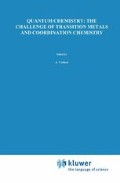Abstract
The successive hydrogenation steps, up to saturation of small platinum clusters Ptn with n between 2 and 13 are studied by the Extended Huckel Method (EHT) with and without spin-orbit coupling. For each hydrogenation step, a large number of possible structures has been calculated in order to determine the stereochemistry of the best stepwise hydrogenated compounds. The resulting structures can be viewed as the progressive build-up of a three-dimensional network of square planar and/or octahedral monometallic complexes. The energy of the first successive steps of dihydrogen adsorption decreases steeply with the hydrogen rate for the smallest clusters. At the contrary, for some of the larger clusters, the first hydrogenation steps are more and more stabilizing before a decrease occurs. The energy of first adsorption depends on the cluster size. The largest value is found with the Pt3 and Pt4 species. These results confirm the interpretation proposed by Fraissard et al. for explaining the observations recently made on platinum clusters supported on zeolites.
Access this chapter
Tax calculation will be finalised at checkout
Purchases are for personal use only
Preview
Unable to display preview. Download preview PDF.
References
B. F. G. Johnson, “Transition Metal Clusters” Wiley Interscience, Chichester, Engl., (1980). E. Muetterties, T. N. Rhodin, E. Band, C. F. Brücker, W.R. Pretzer, Chem. Rev., 79, 91 (1979). P. Gallezot, A. Bienenstock, M. Boudart, Nouv. J. Chim. 2, 263 (1978).
See references 3 therein the present reference 4.
J. P. Fraissard, T. Ito, L. C. de Mé norval, 8th Int. Congress on Catalysis, Berlin (1984). J.P. Fraissard, T. Ito, L. C. de Menorval, M. A. Springuel-Huet. Metals Microstructures in Zeolites, P.A.Jacobs Ed, Elsevier, Amsterdam (1982). Zeolites, P. A. Jacobs Ed, Elsevier, Amsterdam (1982).
B. Bigot, C. Kinot, J. Amer. Chem. Soc., 106, 6601 (1984).
R. Hoffmann, J. Chem. Phys., 39, 1397 (1963).R. Hoffmann, P. Hofmann, J. Amer. Chem. Soc., 98, 598 5 (1976). J.H. Ammeter, H-B. Burgi, R. Hoffmann, J. Amer. Chem. Soc., 100, 3686 (1978).
Author information
Authors and Affiliations
Editor information
Editors and Affiliations
Rights and permissions
Copyright information
© 1986 D. Reidel Publishing Company
About this chapter
Cite this chapter
Bigot, B., Minot, C. (1986). Theoretical Study of the Successive Hydrogenation of Small Platinum Clusters. In: Veillard, A. (eds) Quantum Chemistry: The Challenge of Transition Metals and Coordination Chemistry. NATO ASI Series, vol 176. Springer, Dordrecht. https://doi.org/10.1007/978-94-009-4656-9_35
Download citation
DOI: https://doi.org/10.1007/978-94-009-4656-9_35
Publisher Name: Springer, Dordrecht
Print ISBN: 978-90-277-2237-9
Online ISBN: 978-94-009-4656-9
eBook Packages: Springer Book Archive

